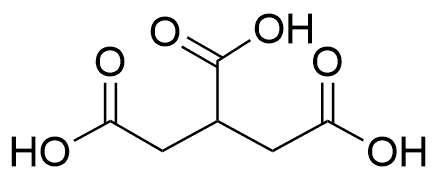Tricarballylic acid is widely utilized in research focused on:
- Food Industry: It serves as a food additive, enhancing flavor and stability in various products, particularly in the formulation of emulsifiers and stabilizers.
- Pharmaceuticals: This compound is used in the synthesis of certain pharmaceuticals, acting as a building block for drug development due to its unique carboxylic acid groups.
- Cosmetics: Tricarballylic acid is incorporated in cosmetic formulations for its moisturizing properties, helping to improve skin hydration and texture.
- Biodegradable Polymers: It plays a role in the production of biodegradable plastics, contributing to environmentally friendly materials that reduce waste.
- Agriculture: The compound is utilized in the formulation of certain fertilizers and soil conditioners, promoting plant growth and improving soil health.
General Information
Properties
Safety and Regulations
Applications
Tricarballylic acid is widely utilized in research focused on:
- Food Industry: It serves as a food additive, enhancing flavor and stability in various products, particularly in the formulation of emulsifiers and stabilizers.
- Pharmaceuticals: This compound is used in the synthesis of certain pharmaceuticals, acting as a building block for drug development due to its unique carboxylic acid groups.
- Cosmetics: Tricarballylic acid is incorporated in cosmetic formulations for its moisturizing properties, helping to improve skin hydration and texture.
- Biodegradable Polymers: It plays a role in the production of biodegradable plastics, contributing to environmentally friendly materials that reduce waste.
- Agriculture: The compound is utilized in the formulation of certain fertilizers and soil conditioners, promoting plant growth and improving soil health.
Documents
Safety Data Sheets (SDS)
The SDS provides comprehensive safety information on handling, storage, and disposal of the product.
Product Specification (PS)
The PS provides a comprehensive breakdown of the product’s properties, including chemical composition, physical state, purity, and storage requirements. It also details acceptable quality ranges and the product's intended applications.
Certificates of Analysis (COA)
Search for Certificates of Analysis (COA) by entering the products Lot Number. Lot and Batch Numbers can be found on a product’s label following the words ‘Lot’ or ‘Batch’.
*Catalog Number
*Lot Number
Certificates Of Origin (COO)
This COO confirms the country where the product was manufactured, and also details the materials and components used in it and whether it is derived from natural, synthetic, or other specific sources. This certificate may be required for customs, trade, and regulatory compliance.
*Catalog Number
*Lot Number
Safety Data Sheets (SDS)
The SDS provides comprehensive safety information on handling, storage, and disposal of the product.
DownloadProduct Specification (PS)
The PS provides a comprehensive breakdown of the product’s properties, including chemical composition, physical state, purity, and storage requirements. It also details acceptable quality ranges and the product's intended applications.
DownloadCertificates of Analysis (COA)
Search for Certificates of Analysis (COA) by entering the products Lot Number. Lot and Batch Numbers can be found on a product’s label following the words ‘Lot’ or ‘Batch’.
*Catalog Number
*Lot Number
Certificates Of Origin (COO)
This COO confirms the country where the product was manufactured, and also details the materials and components used in it and whether it is derived from natural, synthetic, or other specific sources. This certificate may be required for customs, trade, and regulatory compliance.

